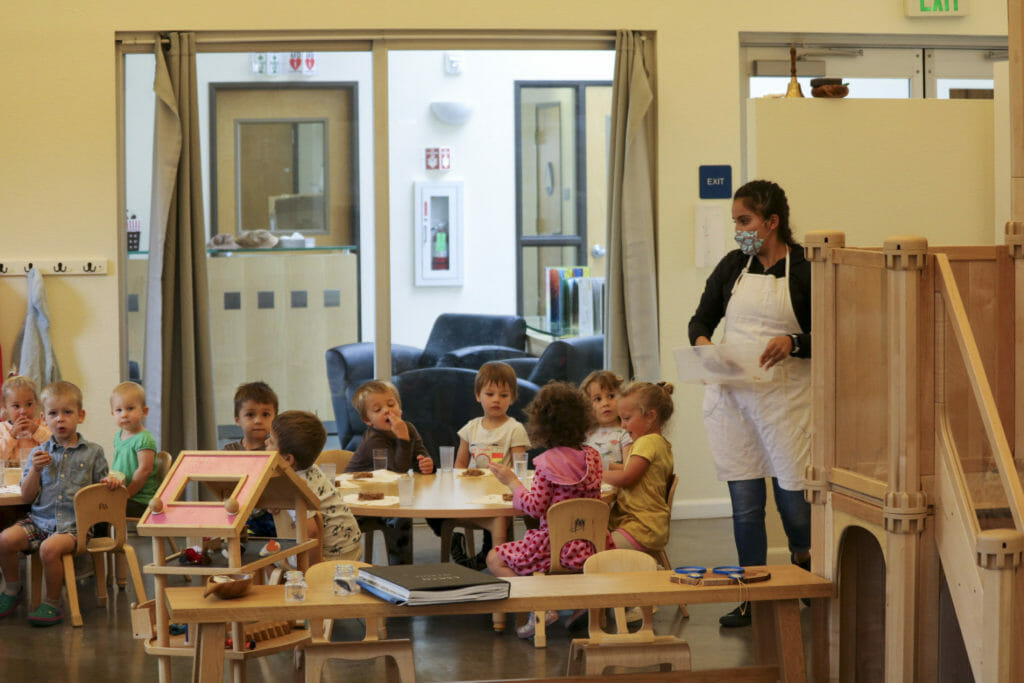Quality early childcare is critical to healthy communities. Access to childcare and child development resources aids the economic stability and well-being of families, which in turn helps improve productivity and the economy in general.
are on childcare wait lists
The Challenge
Since the 2017 California wildfires the childcare landscape in Sonoma County has changed drastically. Fifteen licensed childcare centers were destroyed, displacing 444 children, on top of an already strained childcare system in the region. In the last ten years the childcare industry in Sonoma County has experienced a 21 percent decline, a loss of 295 providers, and the county’s wait list has 1,326 children’s names on it. At the state level, 60 percent of families live in a childcare desert.
In addition to a challenge around availability of care, the high cost of childcare challenges what a family earning a median income can afford. Rates for childcare can be anywhere between $1,000 per month for a child in a family care center to around $1,348 per month for center-based infant care. At these rates, many families are spending 21 percent of their income to keep one child in childcare. Paired with the high cost of housing in the San Francisco Bay Area, that means some families have as much as 80 percent of their income accounted for just in housing and childcare, before other basic necessities are accounted for.
The workforce in Sonoma County is incredibly strained because of these costs. As a result, large and small business alike are seeing employees moving away to less expensive areas either making long commutes or leaving employment completely. Employers are also struggling to recruit new employees and emerging leaders, who have options of San Francisco and Silicon Valley with more housing and childcare options compared to Wine Country.
The Solution
In a collaborative effort, the Santa Rosa Metro Chamber is combining proactive policy advocacy with the development of new partnerships with businesses to increase access to childcare for Sonoma County families by increasing investments in this critical community infrastructure. Although there was a growing acknowledgement of a common objective, the education and business sectors weren’t connected in a meaningful way. The Chamber had established broad credibility through their work in workforce development, education, and family friendly policies and was best positioned to bridge both worlds, conveying the necessity of this investment to the business community, while leaning on the expertise of the early education community for key data, relationships, and solutions.
After formalizing this network it was important to ensure that any progress made would not be hindered by city policy. The Santa Rosa Chamber invited the City’s Economic Development Department to partner in the work of increasing access to childcare. The Chamber, their early education partners, and city officials worked collaboratively on policy changes that would reduce costs for childcare providers and increase confidence in the childcare development process for investors. The City of Santa Rosa is now allowing development of childcare centers as a by-right land use, providing government owned facilities for childcare use during the pandemic, and has allocated significant funding for investment in childcare.
The Santa Rosa Chamber organized and hosted educational forums for local employers that featured speakers from companies like Patagonia and employer-supported childcare experts like Bright Horizons, developed tools to assess return on investment for local employers evaluating childcare options, and created policy tool kits for employers and local government. Now employers are making strides, and significant investments, in childcare solutions for their workforce and the greater community.
“We understand that things critical to our economy today require new work in new areas,” said Santa Rosa Metro Chamber CEO, Peter Rumble. “There is no question that creating capacity in our community to help our children get off to the best start possible supports the strength of today’s workforce as well as creates a stronger workforce tomorrow. We wouldn’t simply be failing our employers if we didn’t engage in this work, we would cutting short our community’s future success.”
Diagnosing the Problem
The lack of access to quality early education and care is as much a local crisis as a national crisis. This crisis negatively impacts economic development and prosperity, economic stability, and the overall well-being of families and communities, especially in disadvantaged communities. Access to childcare is a long-term investment in community health, social equity, and business success.
Challenged by the presence of childcare deserts — nationally, three-in-five rural communities lack adequate childcare supply and nearly sixty percent of the Hispanic/Latino population live in areas with an undersupply of licensed childcare — the Santa Rosa Chamber and its early ed partners pursued solutions that would grease the wheels and allow the development of new childcare centers and more slots for the community’s children.
Key Partners
Progress to date would not be possible without the following key community partners, including a three-year grant from First 5 Sonoma County.
Community Child Care Council of Sonoma County 4Cs
Child Care Planning Council
City of Santa Rosa
County of Sonoma
Local and National Child Care Providers
Local Employers
Local school districts and the county office of education
4.1 Million
children served by grant-funded programs and mobile educational tours
747,000
employee volunteer hours through a policy permitting up to 40 hours of paid time off for volunteerism
$137M in Grants
Distributed to Head Start and other organizations that support early childhood education
Key Tactics & Hurdles
First, the Santa Rosa Chamber convened elected officials and community leaders to make the case that lack of access to childcare negatively affects the entire community and requires collaborative, community-wide solutions. They worked with city staff to update city code to better enable the development of new childcare centers and the expansion of existing facilities. As a result, the City Council approved multiple policy changes resulting in eliminated or lowered fees for childcare development and reduced levels of review for permitting of childcare facilities.
Secondly, the chamber worked with employers to help them understand the immediate and future benefits of their investments in early education and care. They provided employers with data, proforma budgets, model examples, and planning tools, and hosted regular meetings to discuss relevant topics and answer employer’s questions.
This journey included hurdles such as a lack of return-on-investment data for employer supported childcare, employer concerns around liability and universally usable benefits, and hesitancy about the business community stepping into the childcare arena.
Is This a Repeatable Model?
This campaign in Sonoma County is starting to show real results, with an employer recently approved to spend several million dollars for a new onsite childcare center, providing 112 new slots to be available to their employees and the community. This is a huge win and will be the first example of employer childcare in the county.
Sonoma County Supervisor Lynda Hopkins celebrated the announcement saying, “Here we have a perfect example of how the private sector can lead the way. Keysight has set an example that I hope our government agencies, as large employers, can follow.”
Through this process, the Santa Rosa Chamber learned two important lessons: 1) there are innumerable reasons that a business might choose to invest in childcare and each company is motivated by different factors, and 2) that the Santa Rosa Chamber and it’s early education partners needed to understand the type of resource and support each business was looking to them to be throughout the process. Understanding the uniqueness of each employer’s needs and motivations has been critical to their success.
In any community in the country, convening relevant community partners, working collaboratively to leverage each stakeholder’s expertise, and speaking with one voice about the return on investment for a community and an employer’s workforce is a repeatable model.
Addressing the Childcare Need and the Impact of COVID-19
Pre-pandemic, the Santa Rosa Metro Chamber had made tremendous local progress in creating cross-sector partnerships and in recovering some of the childcare slots lost during the local wildfire disasters. They advocated for local policies to encourage childcare development and as a result of their efforts in employer supported childcare, the first major employer began development of an on-site childcare center.
Strategically considering a post-COVID world, the goal is to use the strong local foundation and coalitions, while pivoting to meet the most critical immediate needs and embracing changing opportunities for systems change and mid-term and long-term solutions to our childcare crisis. The main goals are to stabilize child care business and support opportunities for distance learning childcare cohorts; expand childcare capacity; and encourage new facilities and exploration of opportunities to rehab existing facilities.
The Santa Rosa Metro Chamber paired local data on the COVID-19 impact on childcare availability with findings from the U.S. Chamber Foundation’s Untapped Potential data to hold local discussions and presentations on the economic impact of the breakdowns in childcare. These discussions made the case that economic growth and recovery depends on treating childcare as essential infrastructure, and that investments in childcare will result in immediate and long-term returns on investment.




